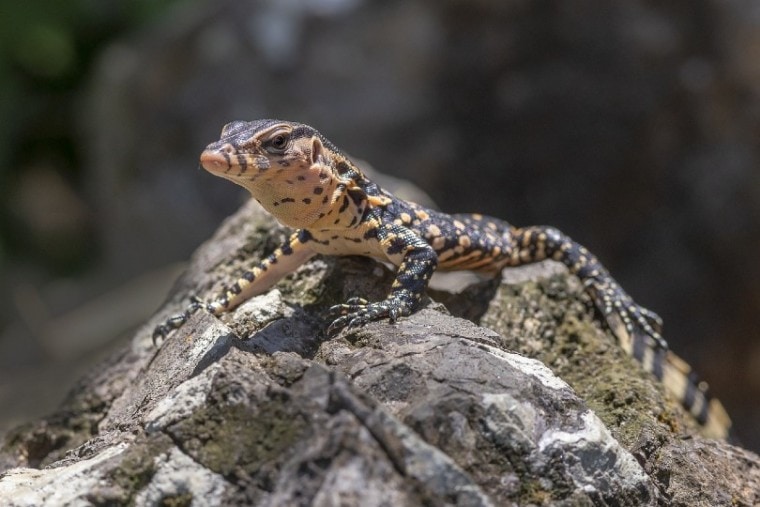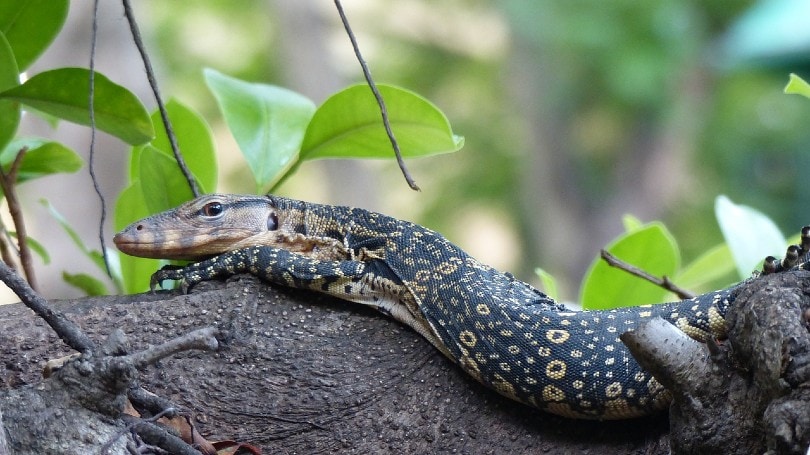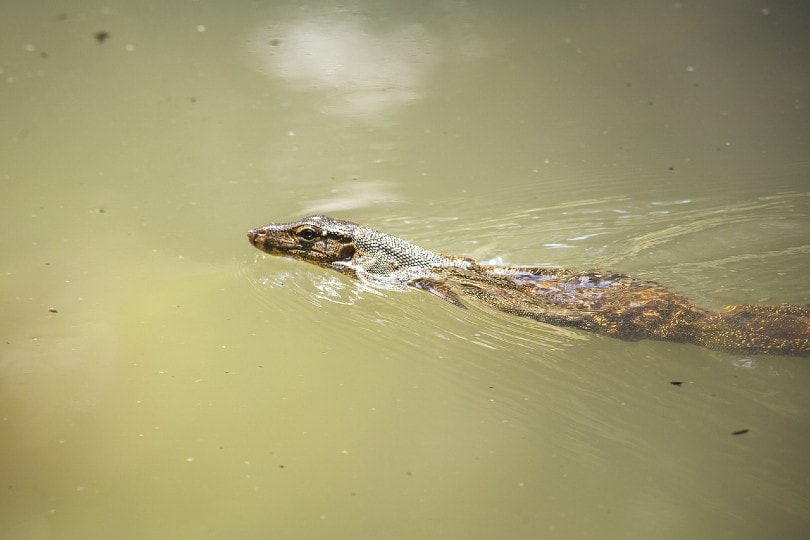
If iguanas and snakes don’t do it for you, you may want to consider moving on to something a bit more impressive: the Asian Water Monitor. These giant reptiles are undoubtedly spectacular, but they’re also unbelievably difficult (expensive) to own.
These massive beasts aren’t for rookies, so only consider bringing one home if you have plenty of experience with exotic pets. You’ll need plenty of space too, as it’s not like you can just stuff one in a fish tank.
Still, if you want a pet that’s bound to impress everyone who comes over, the Asian Water Monitor is the way to go.
Quick Facts About Asian Water Monitor
| Species Name: | Varanus salvator |
| Family: | Varanidae |
| Care Level: | High |
| Temperature: | 85°F ambient, 125°F – 140°F in basking area |
| Temperament: | Intelligent, curious, calm, approachable |
| Color Form: | Dark brown to black with yellow dots |
| Lifespan: | 10 – 25 years in captivity |
| Size: | 5 – 8 feet (males), 4 – 6 feet (females) |
| Diet: | Insects, raw chicken, mice, fish, eggs |
| Minimum Tank Size: | 4’ x 8’ x 8’ |
| Tank Set-Up: | Complex |
| Compatibility: | Poor |
Asian Water Monitor Overview
The Asian Water Monitor is the world’s second-heaviest lizard, clocking in just a few pounds shy of the Komodo Dragon. Unlike their larger cousins, however, they have been known to make pleasant and amiable pets — provided that you know what you’re doing with them, of course.
They have serrated teeth, sharp claws, and powerful jaws, all of which can do a number on an unsuspecting owner. For this reason, it’s illegal to own one in many places, so check your local laws before whipping out your credit card.
They have fairly complicated needs because everything from their housing situation to their health requires specialized care. These are not hands-off pets to own, and if you want something primal and majestic in your home, they’re up there with exotic cats and enormous snakes.
You’ll likely need to build a specialized habitat for them, and those costs alone can run into the thousands. They’ll also require plenty of expensive care after the initial outlay, so the price of ownership won’t drop after the first month or so.
Still, there are few experiences like watching one of these primitive beasts rip through their prey with unbelievable savagery, only to accept petting or handling from their owners a few minutes later. They’re not for everyone, but it’s not hard to see why some people would fall in love with these huge lizards.

How Much Do Asian Water Monitors Cost?
There’s an old saying that applies to Asian Water Monitors quite nicely: “If you have to ask, you can’t afford it.”
These are unbelievably expensive pets, both in terms of purchasing one and then taking care of them. You may be able to find a hatchling for $300 or so, but unless you’re an expert, keeping it alive until it’s fully grown can be a herculean task.
A fully mature, pre-socialized Asian Water Monitor can easily cost $15,000 or more. They’re extremely high in demand, and owning one is quite the statement in some circles.
Purchasing an Asian Water Monitor is one thing; keeping it alive is quite another. They need plenty of water, and building and maintaining an aquatic habitat for an 8-foot lizard isn’t cheap. Their enclosures can be truly massive, and they require frequent cleaning, not to mention regularly replacing all that water.
It’s no exaggeration to say that owning one of these animals can cost you thousands of dollars a year on the low end. If price matters to you at all, this is not the pet for you.
Then again, if you want to prove to your houseguests that money means nothing to you, there are few ways to do so that are more impressive than sharing your home with a medium-sized dinosaur.
Typical Behavior & Temperament
Evaluating the temperament of these lizards has to be done in context. Many people will tell you that this is an extremely friendly and sociable pet, and that’s true — in comparison to say, a snake or a Komodo Dragon.
They’re not like that straight out of the box, though. They’ll need plenty of socialization before they’ll accept human handling, and even then, it has to be done properly.
They’re smart, though, and watching them explore their surroundings (and hunt their prey) can be endlessly fascinating. They’re typically active from dawn until late afternoon, so they’ll be awake and moving around at the same time that you are.

Appearance & Varieties
While Asian Water Monitors can be quite heavy, weighing 30 to 60 pounds (and sometimes, as much as 200 pounds), there’s usually not much fat on them at all. They’re deeply muscled and intensely powerful, and their stout tails can generate a ton of force.
Both their tails and necks are extremely long, sticking far out from their bodies and giving them a slightly cartoonish appearance. They look like someone’s poor attempt at drawing an alligator, in fact.
The neck and tail serve important purposes for the lizards, however. The animal hunts by running down its prey and sinking its serrated teeth into the other animal’s flesh; then, while its powerful jaws clamp down on its quarry’s body, its necks will thrash the body around, breaking the animal’s neck and decimating its internal organs.
The tails, on the other hand, are paddle-like, making these lizards fast and agile swimmers. They’re equally fast on land as well, so any animal unfortunate enough to be the target of their pursuit isn’t likely to escape.
The Asian Water Monitor will then swallow its food whole if it’s small enough or rip chunks of flesh off with its razor-sharp teeth and gobble them down.
These lizards’ bodies are covered in scales, with the scales at the top of the head larger than those on their backs. They’re usually dark brown or black and often have yellow spots on their undersides that fade as they get older.

How to Take Care of Asian Water Monitors
Habitat, Tank Conditions & Setup
Habitat
You’re not going to be able to just waltz into your local pet store and buy an aquarium for one of these animals; instead, you’ll likely need to build the habitat yourself (or have a professional do it).
If you start with a hatchling, you can likely keep them in a 100-gallon aquarium for the first few months, but soon, you’ll need to move them to something bigger. The more space that you can offer these lizards, the better, but the cage needs to be 4’ x 8’ x 8’ at the minimum.
You can’t just put a bunch of chicken wire around the corner of your yard either. They’re capable climbers, so the top needs to be as secure as the sides, and you’ll often find them hanging out at the highest part of their enclosure.
Water
The Asian Water Monitor’s habitat needs a large pool in their enclosure for swimming and bathing.
This pool must be big enough for it to completely submerge its body, but ideally, it should be quite a bit larger than that. It should be able to get a good swim in when it feels like it, as that will improve both its physical and mental health.
The lizard may kill its prey in this pool, however, and it seems to prefer defecating in water, so that pool will need to be emptied and refilled regularly. This can be expensive, and you’ll also need a good way to dispose of all that water.
Don’t neglect to keep the water clean, though, as dirty water is one of the leading causes of illness in these lizards.
Temperature
The ambient temperature of the enclosure should be around 80°F. Humidity is just as important as the temperature, though, and you want to keep the moisture levels around 70%. Fortunately, the large pool in the tank makes it easy to do that.
Like all reptiles, Asian Water Monitors are cold-blooded, and they need a basking spot that allows them to quickly warm their bodies when necessary. This basking area should be kept between 120° and 150°F, and it will require multiple basking lamps to ensure that your lizard’s entire body is covered.
Decorations
Asian Water Monitors are intelligent, so their habitats need to be visually stimulating and engaging. Trees, sturdy branches, and pipes are all great additions to the tank, as these give them spaces to climb and explore.
You can also build a series of wooden platforms so they can have opportunities to rest on different levels. Live plants are a nice touch too.
These animals like to dig as much as climb, so the enclosure should extend a few feet into the ground. You can also cover the bottom of the tank with mulch, sand, or topsoil, giving them plenty of material to claw through.
It will need a hide box, which is essential to its mental health. A hide box is just what it sounds like: a place the lizard can hide in when it feels threatened. Many people make the hide box do double duty as a basking spot, but that’s not necessary. You can build a simple hide box yourself or buy one; all that matters is that the lizard can enter and exit it comfortably.
Lighting
These animals are most active between dawn and dusk, so if you have them outdoors or in a room with natural light, additional lighting isn’t necessary. Otherwise, you should add lights that can simulate a day/night cycle.
You can also use lights to increase the temperature of the tank. If you do this, make sure the lights aren’t close enough that the lizard could burn themselves on them.

Do Asian Water Monitors Get Along With Other Pets?
Life in the wild can be difficult for Asian Water Monitors. They have to compete for food and territory with all sorts of other animals, including other Asian Water Monitors.
As a result, they tend to be solitary and highly territorial creatures. They don’t appreciate other animals in their space, and any organism unlucky enough to enter their territory will likely be seen as either a threat or a meal.
That means that you really shouldn’t keep any other animals in the tank with your Asian Water Monitor, as that situation isn’t likely to end well. The only time that you should keep two of these lizards in the same cage is if you’re trying to breed them, and even then, it should be done sparingly and under highly controlled conditions.
What to Feed Your Asian Water Monitor
In nature, Asian Water Monitors are largely scavengers, so they’re opportunistic eaters. That means you have to be careful about how often you feed them, as they’ll keep eating as long as food is available. This makes it easy for them to become obese, which is terrible for their health.
Hatchlings need to eat every day, and they’ll largely dine on insects like gut-loaded crickets or Dubai roaches. When they get older and turn into yearlings, you can cut the feedings down to three to four times per week and start introducing foods like rodents, fish, and chicken.
Once they’re fully mature, they only need to eat two or three times per week. They’ll eat almost anything, but most people feed them insects, mice, hard-boiled eggs, organ meats, or chicks and ducklings. They have also been known to eat catfish and other aquatic prey.
Given that they love to scavenge, you don’t necessarily need to give them fresh food. They’ll happily chow down on pre-killed prey.
Keeping Your Asian Water Monitor Healthy
These impressive lizards are big, powerful, and intimidating, so it’s somewhat surprising to learn that they’re relatively frail from a health perspective. You need to take special care to keep them in tip-top condition.
The basking area is especially important, as it helps regulate their digestive enzymes and ensure that their meals are fully digested. Without one, food is likely to become impacted, causing constipation and possibly even death.
They’re quite prone to respiratory issues as well. This is why it’s important to keep the enclosure at the perfect temperature and humidity; if it gets too cold or damp inside, these lizards may get an infection.
Many lizards suffer severe burns from poorly placed heat lamps and other equipment, so be sure that all your gear is out of their reach. While these animals are intelligent, they’re not smart enough to avoid cooking themselves, so you’ll have to do the thinking for both of you.
Keeping the tank clean is equally important. Mold and bacteria will grow in an unkempt tank, and these lizards aren’t adept at fighting off biological invaders. Please note that “keeping the tank clean” means both the dry and wet portions, so don’t let the water sit too long.
Breeding
The actual act of breeding Asian Water Monitors is quite simple, as all you have to do is put two suitable lizards together and wait for things to progress naturally. Getting to that point, however, is quite difficult, and even many experienced breeders have trouble doing so.
It’s surprisingly difficult to tell a male from a female, so finding a fully mature and properly sexed pair can be a challenge. You’ll also need to be sure that both animals are healthy and at a proper weight before beginning.
Learning the female’s cycle is also important. Females tend to eat quite a bit more at certain times of their cycle, so it’s essential that you provide them with all the nutrition necessary to handle the stress of mating and bearing young.
If a pairing is successful, the female will lay a clutch of six to 18 eggs 30 to 45 days afterward. You will need to provide her with ample substrate to ensure that she can nest with her new clutch, at which point, you can transfer the eggs to a plastic container filled with Hatchrite and kept at 86°F.
If properly cared for, the eggs should begin to hatch in 7 or 8 months.

Are Asian Water Monitors Suitable for You?
Owning an Asian Water Monitor can be both expensive and challenging, but the rewards are commensurate to the difficulty. These lizards can be quite amiable while still being powerful and intimidating, and guests are sure to be wowed by your giant pet.
Bringing one home isn’t a commitment to be taken lightly, though. These animals need plenty of hands-on care, not to mention a ton of space at your home. Only experienced reptile handlers should attempt ownership of one of these lizards.
For those who are successful, though, the Asian Water Monitor will be an impressive pet that may actually grow to like you over time.
- Next on your reading list: Can Komodo Dragons Be Kept as Pets? What You Need To Know!
Featured Image Credit: Erik Karits, Pixabay








